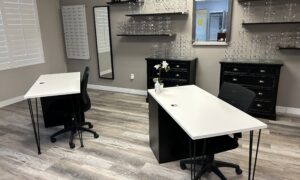By Carla Gasparini, OD

Jan. 30, 2019
A full month into the New Year, and some practices, maybe even yours, have not created a 2019 budget. Analyzing my expenses and profits from the previous year, and then making changes for the coming year, is an important way I remain profitable in my 13-year-old practice, which operates independently within a Walmart in Austin, Texas.
I don’t sell glasses, so profitability is based solely on patient encounters. I’m also limited by space in a corporate lease, so each instrument I purchase must make money for the office. We must have the volume of patients to make up for not selling optical materials. For example, I was hesitant to purchase an EHR system and retinal camera. I began by tracking the number of pathology patients I was sending out to OMDs, and made my decision to purchase based on those figures.
Use Online Tools & Software to Help You Forecast
I use Quickbooks Online. I prefer to do the bookkeeping myself, so I can get a real-time picture of how things are going financially. I use the Profit and Loss and Balance Sheet (monthly/quarterly) functions within Quickbooks.
I usually start at the end of the calendar year or beginning of the New Year. Forecasting shifts in demographics and practice health can be hard if you do not have the hard numbers in front of you. You can do this quarterly, so you can make changes that reflect the true pattern seen without disrupting a practice too much. My costs in a corporate practice are mostly set except for employees and supplies.
Once I have all my expenses in Quickbooks, I look at the overall trend in payroll, insurance reimbursement vs. cash-pay patients, cost of office supplies and services. Increases in fees for services we use (i.e. accountant or IT specialists) are usually shared with us by the companies we outsource to at the end of the year. I then place all expenses related to companies we use for business services into a spreadsheet.
My accountant and IT services are typically my largest fixed costs since I pay a set amount per month via contract. Rent increases can also eat up your budget, so if there is wiggle room for negotiation, you must speak up. Rent within a corporate lease are fixed (market rate), but if the burden became too costly I would need to negotiate.
Editor’s Note: Be sure to check with your local state board of optometry to make sure your rental lease does not violate board rules.
Sometimes your analysis of past business service expenses shows opportunities for savings. When setting up my third office, I needed to keep my EHR set-up costs down, so I hired a friend of one of my long-term employees to set up my computer network. I paid a negotiated per-hour fee for his expertise (independent contractor) and came out ahead instead of hiring an IT company. I’ve since hired a company (on call) to cover incidentals like mother boards crashing that can come within a two-hour window and help my office to stay running.
Other Articles to Explore
Key Points to Watch For in Analysis of Past Year’s Numbers
Most importantly, I look at the ratio between fixed cost (i.e. malpractice insurance and rent) and variable cost (i.e. employees salaries, office supplies) items. I also take into account the overall trend in business, such as an increase in insurance reimbursement or overall cash flow.
Factor in Practice Growth Goals
If you are planning to invest in a new instrument or technology for your company, you will have to generate a certain amount of income to pay it off and make a profit. Profitability and return on investment are key since no one wants to have to languish with a loan payment that is not payable in the long run and takes away from the practice cash flow.
A plan must be in place that introduces this technology to your patient base through strategic advertising within the practice – involvement of staff in promotion of the new technology and a general push from the OD asking patients to agree to this new type of testing.
For instance, I am working on being able to buy an OCT for my practice. This is going to take careful consideration since my numbers within the diabetic, glaucoma, macular degeneration patients, and others with medical eyecare needs, must hit a threshold that could make this a worthwhile investment.
It’s always harder to ask patients to agree to pay out-of-pocket for advanced screening if there isn’t a reason to do so. I try to be as transparent as possible to patients as to why I need them to spend extra money to do their exam if there is medical pathology that needs addressing. Vision plans are not covering OCT screenings, so these costs for some patients will hit their pocket book directly.
If a new glaucoma suspect returns for their photos and visual fields on their second visit, they must be told
that their OCT will be performed on a different day. This revenue can only be included if there is a push from the doctor.
Build Flexibility Into Your Budget
I like to budget about 5-10 percent of the overall budget in a “miscellaneous fund,” which can help cover under-performance or loss. In 2015, one of my offices was flooded by a freak rainstorm. Unfortunately, my insurance policy didn’t cover the loss of business (note to self: get flood insurance), and we had to shut down to have the office walls and floors redone. That extra money helped keep the office afloat while staff was shifted to the other two offices to keep their paychecks.
 Carla Gavilanes Gasparini, OD, is the owner of Capital Eye Care & Hill Country Eye Care in Austin, Texas. To reach her: gaspariniod@gmail.com
Carla Gavilanes Gasparini, OD, is the owner of Capital Eye Care & Hill Country Eye Care in Austin, Texas. To reach her: gaspariniod@gmail.com

























